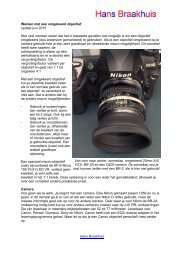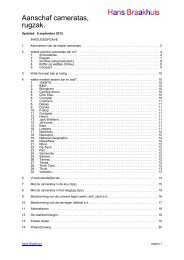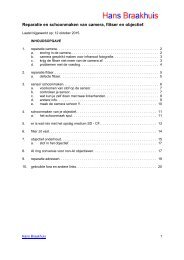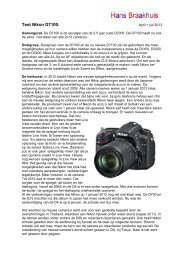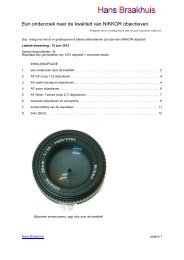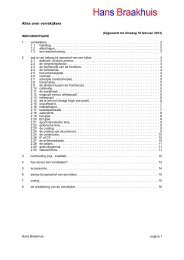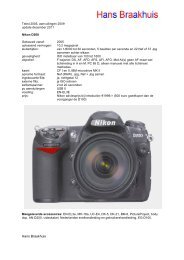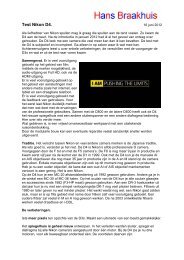The history of Nikon binoculars. Updated: 3 Feb ... - Hans Braakhuis
The history of Nikon binoculars. Updated: 3 Feb ... - Hans Braakhuis
The history of Nikon binoculars. Updated: 3 Feb ... - Hans Braakhuis
You also want an ePaper? Increase the reach of your titles
YUMPU automatically turns print PDFs into web optimized ePapers that Google loves.
<strong>The</strong> <strong>history</strong> <strong>of</strong> <strong>Nikon</strong> <strong>binoculars</strong>.<br />
<strong>Updated</strong>: 26 May 2015<br />
Table <strong>of</strong> contents<br />
1 introduction. . . . . . . . . . . . . . . . . . . . . . . . . . . . . . . . . . . . . . . . . . . . . . . . . . . . . . . . . 2<br />
2 before Fujii Lens Seizo-sho. . . . . . . . . . . . . . . . . . . . . . . . . . . . . . . . . . . . . . . . . . . . . 3<br />
3 Fujii Lens Seizo-sho.. . . . . . . . . . . . . . . . . . . . . . . . . . . . . . . . . . . . . . . . . . . . . . . . . . 4<br />
4 Nippon Kogaku K.K... . . . . . . . . . . . . . . . . . . . . . . . . . . . . . . . . . . . . . . . . . . . . . . . . 15<br />
1. <strong>The</strong> Joico <strong>binoculars</strong>.. . . . . . . . . . . . . . . . . . . . . . . . . . . . . . . . . . . . . . . . . . . . 17<br />
2. <strong>The</strong> Nikko <strong>binoculars</strong>. . . . . . . . . . . . . . . . . . . . . . . . . . . . . . . . . . . . . . . . . . . . 19<br />
3. <strong>The</strong> Mikron <strong>binoculars</strong>.. . . . . . . . . . . . . . . . . . . . . . . . . . . . . . . . . . . . . . . . . . . 26<br />
4. <strong>The</strong> Manchuria <strong>binoculars</strong>.. . . . . . . . . . . . . . . . . . . . . . . . . . . . . . . . . . . . . . . . 27<br />
5. <strong>The</strong> <strong>Nikon</strong> <strong>binoculars</strong>. . . . . . . . . . . . . . . . . . . . . . . . . . . . . . . . . . . . . . . . . . . . 28<br />
5 other binocular companies. . . . . . . . . . . . . . . . . . . . . . . . . . . . . . . . . . . . . . . . . . . . . 28<br />
5.1 Earth Kogaku. . . . . . . . . . . . . . . . . . . . . . . . . . . . . . . . . . . . . . . . . . . . . . . . . . 28<br />
5.2 Asahi Kogaku. . . . . . . . . . . . . . . . . . . . . . . . . . . . . . . . . . . . . . . . . . . . . . . . . . 28<br />
5.3 Takachiho Seisaku Sho. . . . . . . . . . . . . . . . . . . . . . . . . . . . . . . . . . . . . . . . . . 28<br />
5.4 Nichi-Doku Shashinki Shokai. . . . . . . . . . . . . . . . . . . . . . . . . . . . . . . . . . . . . . 28<br />
5.5 Tokyo Optical. . . . . . . . . . . . . . . . . . . . . . . . . . . . . . . . . . . . . . . . . . . . . . . . . . 29<br />
5.6 Seiki Kogaku Kenku Sho. . . . . . . . . . . . . . . . . . . . . . . . . . . . . . . . . . . . . . . . . 29<br />
5.7 Fuji. . . . . . . . . . . . . . . . . . . . . . . . . . . . . . . . . . . . . . . . . . . . . . . . . . . . . . . . . . 29<br />
5.8 ??. . . . . . . . . . . . . . . . . . . . . . . . . . . . . . . . . . . . . . . . . . . . . . . . . . . . . . . . . . . 29<br />
5.9 JB and JE codes.. . . . . . . . . . . . . . . . . . . . . . . . . . . . . . . . . . . . . . . . . . . . . . . 30<br />
6 justification.. . . . . . . . . . . . . . . . . . . . . . . . . . . . . . . . . . . . . . . . . . . . . . . . . . . . . . . . 30<br />
6.1<br />
6.2<br />
credits. . . . . . . . . . . . . . . . . . . . . . . . . . . . . . . . . . . . . . . . . . . . . . . . . . . . . . . .<br />
links for more <strong>binoculars</strong> and telescopes. . . . . . . . . . . . . . . . . . . . . . . . . . . . .<br />
30<br />
31<br />
6.3 literature. . . . . . . . . . . . . . . . . . . . . . . . . . . . . . . . . . . . . . . . . . . . . . . . . . . . . . 31<br />
<strong>The</strong> author at the Togo shrine in Tokyo<br />
<strong>Hans</strong> <strong>Braakhuis</strong> 1
1 introduction<br />
On this page: http://nikon.topica.ne.jp/bi_e/<strong>history</strong>/<strong>history</strong>.htm<br />
the <strong>Nikon</strong> Corporation<br />
tells about their <strong>history</strong> in<br />
<strong>binoculars</strong>. In 2008 the<br />
Topica site stopped.<br />
<strong>The</strong>re is more to tell. <strong>The</strong><br />
Topica picture is far from<br />
complete.<br />
On my website you will<br />
find a more complete<br />
Excel list <strong>of</strong>f all<br />
<strong>binoculars</strong> the Fujii Lens<br />
Seizo-sho, Nippon<br />
Kogaku K.K. and <strong>Nikon</strong><br />
made, that I know. And<br />
even my file is not<br />
complete.<br />
<strong>The</strong> <strong>history</strong> <strong>of</strong> <strong>Nikon</strong><br />
starts with the founding<br />
<strong>of</strong> Nippon Kogaku K.K. in<br />
1917. Nippon Kogaku<br />
K.K. became later <strong>Nikon</strong>.<br />
One <strong>of</strong> the predecessors<br />
<strong>of</strong> Nippon Kogaku K.K.<br />
was Fujii Lens Seizo-sho.<br />
(Fujii Optical Works)<br />
Other authors use other<br />
names for the same<br />
factory such as “Fujii<br />
Lens” or “Fujii Brothers”.<br />
From <strong>Nikon</strong>’s website, but not complete !<br />
<strong>Hans</strong> <strong>Braakhuis</strong> 2
2 before Fujii Lens Seizo-sho<br />
Barr & Stroud 4½ Feet<br />
Type FA2 Range Finders<br />
became well known in the<br />
19th century. <strong>The</strong>y were<br />
introduced by Barr &<br />
Stroud, (Glasgow, since<br />
1860, now part <strong>of</strong><br />
Pilkington Optronics) in<br />
1888 and the very high<br />
tech oriented Japan Navy<br />
immediately ordered<br />
them. <strong>The</strong> first one,<br />
bearing serial number 4,<br />
was installed on a<br />
Japanese battle ship in<br />
1894. By May 27, 1905,<br />
every single battle ship <strong>of</strong><br />
Japan’s Imperial Navy<br />
was equipped with this<br />
range finder, in fact every<br />
single cannon! So this will<br />
have cost Japan a lot <strong>of</strong><br />
Yen.<br />
Admiral Togo on the bridge <strong>of</strong> batlleship Mikasa,<br />
at the beginning <strong>of</strong> the Battle <strong>of</strong> Tsushima, in 1905. He has an Zeiss<br />
binocular. On the background an Barr & Stroud rangefinder<br />
<strong>The</strong> Japanese army used<br />
Carl Zeiss <strong>binoculars</strong>. On the picture <strong>of</strong> a small monument in Tokyo, you see Admiral Togo<br />
with a so called “Marine-glas mit Revolver” and this binocular has been immortalised by<br />
Admiral Togo <strong>of</strong> the Japanese Imperial Navy. Because <strong>of</strong> this binocular he became the victor<br />
<strong>of</strong> the naval battles <strong>of</strong> Port Arthur and Tsushima in 1904/05. His bronze statue, complete<br />
with one <strong>of</strong> these <strong>binoculars</strong> can be seen in Yokosuka in Japan beside his flagship the<br />
Mikasa.<br />
See: http://en.wikipedia.org/wiki/Togo_Heihachiro<br />
See: http://akiroom.com/redbook-e/kenkyukai05b/kenkyukai200510.html<br />
Zeiss <strong>binoculars</strong> were already imported by Konishi Honten (Konica) at the end <strong>of</strong> the 19 th<br />
century in Japan and was used by the Japanese Navy. In 1904, Zeiss sold already for RM<br />
40,000,= <strong>of</strong> optical products in Japan. (RM = Reichs Mark) In 1911, Zeiss itself started with a<br />
shop: Carl Zeiss Göshi Kaisha in <strong>The</strong> Tsukiji (Chuo-Ku, Tokyo).<br />
That is in the same district where also the Japanese army then had<br />
an optical research laboratory, the Tsukiji Arsenal. Mr. Michael<br />
Rauck was the first manager at Zeiss in Japan.<br />
Before the first world war, the Navy had launched its own production<br />
<strong>of</strong> sextants, periscopes, and other optical precision instruments.<br />
<strong>The</strong> Navy also established its own research laboratory. <strong>The</strong>se<br />
plants were destroyed during the Great Kanto earthquake strike in<br />
September 1923.<br />
During the first world war Japan choose the side <strong>of</strong> the Allied<br />
Forces. So the imports <strong>of</strong> German Zeiss <strong>binoculars</strong> and lenses<br />
stopped. And also the import <strong>of</strong> Schott optical glass stopped. That<br />
was the reason that the military forces in Japan needed a furnace<br />
and a plant for manufacturing optical glass.<br />
“Marine glas mit<br />
revolver”, turret<br />
binocular from Admiral<br />
Togo. (picture from<br />
<strong>Nikon</strong> Kenkyukai<br />
Tokyo)<br />
<strong>The</strong> Japanese Government asked Mitsubishi for help. And in 1917 Nippon Kogaku was born,<br />
starting developing, recruiting and building a plant.<br />
<strong>Hans</strong> <strong>Braakhuis</strong> 3
3 Fujii Lens Seizo-sho<br />
In 1909 (In the Japanese Photo Industry 1958 it says: Production on an industrial scale<br />
started in 1907 with the establishment <strong>of</strong> the Fujii Lens Factory, which manufactured<br />
<strong>binoculars</strong> for the civilian market as well for use by the Imperial Japanese Navy (page 140)).<br />
Fujii Lens Seizo-sho opened a factory (after renting a dirt floor room in a residence, for<br />
research work) in Tokyo.<br />
To manufacture <strong>binoculars</strong> in that period in<br />
Japan, polishing machines and measuring<br />
instruments, optical glass materials were<br />
imported from Germany in those days. It is<br />
marvellous that Ryuzo and Kozo Fujii<br />
produced the first Japanese prismatic<br />
<strong>binoculars</strong> only about 15 years after Zeiss<br />
produced their first one.<br />
Fujii Lens Seizo-sho was the first binocular<br />
manufacturer in Japan, producing their first<br />
model with prism in 1911. This was the Fujii<br />
Brothers Victor 8x20.This binocular was<br />
Ryuzo Fujii sold to the Imperial Navy. <strong>The</strong> Imperial<br />
Army and Navy placed enormous orders for<br />
telescopes and <strong>binoculars</strong>.<br />
Kozo Fujii<br />
<strong>The</strong> first Victor is also called: “Tenyu”, and was designed after studying prismatic <strong>binoculars</strong><br />
made by Ross (Britain). Butt also Krauss in Paris is mentioned. It is written in "Kogaku<br />
<strong>The</strong> first Fujii Lens Seizo-sho, Victor, 8x20, prismatic binocular, 1911<br />
Kaikoroku" that Ryuzo Fujii stayed in Britain and purchased a pair <strong>of</strong> <strong>binoculars</strong> made by<br />
Ross in around 1897. That was one <strong>of</strong> the first Ross 6x prismatic model.<br />
<strong>Hans</strong> <strong>Braakhuis</strong> 4
Fujii Lens Seizo-sho, Victor Nr. 2, 8x<br />
Fujii Lens Seizo-sho, Victor, 8x20, 1911<br />
<strong>Hans</strong> <strong>Braakhuis</strong> 5
Fujii Lens Seizo-sho, Victor Nr. 2, 8x<br />
<strong>Hans</strong> <strong>Braakhuis</strong> 6
Fujii Lens Seizo-sho, Victor Nr. 4, 6x<br />
Fujii Lens Seizo-sho, Victor Nr. 4, 6x<br />
<strong>Hans</strong> <strong>Braakhuis</strong> 7
Fujii Lens Seizo-sho, Victor Nr. 5, 6x<br />
<strong>Hans</strong> <strong>Braakhuis</strong> 8
Fujii Lens Seizo-sho, Victor Nr. 6, “Asahi”, 6x<br />
Fujii Lens Seizo-sho, Victor Nr. 6, “Asahi”, 6x<br />
<strong>Hans</strong> <strong>Braakhuis</strong> 9
Fujii Lens Seizo-sho, from left: Victor 1911, Victor Nr. 6, Victor Nr 5,<br />
Victor Nr. 4, Victor Nr. 2<br />
Fujii Lens Seizo-sho, Victor Nr. 5<br />
<strong>Hans</strong> <strong>Braakhuis</strong> 10
From left: Fujii Lens Seizo-sho Victor Tenyu, Galilean type 3x,<br />
Nippon Kogaku Novar 3x (picture from <strong>Nikon</strong>’s 75 Years History<br />
book)<br />
<strong>The</strong> Nippon Kogaku 3x probably the same as the<br />
Fujii Seizo-sho Galilean type. (picture from <strong>Nikon</strong>’s<br />
75 Years History book)<br />
<strong>Hans</strong> <strong>Braakhuis</strong> 11
With the successful test run <strong>of</strong> Victor <strong>binoculars</strong>, the Fujii Brothers decided in 1912 to<br />
venture in the mass production <strong>of</strong> optical instruments. <strong>The</strong>ir production <strong>of</strong> <strong>binoculars</strong> was to<br />
be increased, and they planned also to begin melting optical glass. <strong>The</strong> new glass shop was<br />
a direct result <strong>of</strong> the experience and knowledge gained by the company. To house these<br />
activities, a much larger second building was constructed.<br />
Fujii Lens Seizo-sho, Victor, nr.2, 8x<br />
In 1913, with its increased manufacturing capacity, Fujii Lens brought out a variety <strong>of</strong> prism<br />
and Galileo-type <strong>binoculars</strong>. <strong>The</strong>se <strong>binoculars</strong> were called (interestingly enough!) "Nihongo",<br />
and had 6x24 and 8x24 fields for the prism models. Later in the same year the company<br />
introduced a refractive-type telescope. See the complete article from John Baird about this<br />
item in NHS Journal 29.<br />
<strong>The</strong> WWI brought on difficulties in obtaining the German optical glass used in these early<br />
models, but production continued. 6x15 and 6x20 <strong>binoculars</strong> were exported to Russia and<br />
England.<br />
In Fujii's 1912 catalogue, it is written that Fujii Lens<br />
Seizo-sho was recommended by Japanese army and<br />
navy to change name <strong>of</strong> their <strong>binoculars</strong> from English<br />
name "Victor" to Japanese name.<br />
<strong>The</strong> Fujii lens Seizo-sho “Asahi” has also a Fujii<br />
engraving. It has no relation with Asahi Kogaku<br />
(Pentax). Asahi Kogaku even didn't exist then. Asahi<br />
marking on this pair is just the name <strong>of</strong> the <strong>binoculars</strong>.<br />
<strong>The</strong> Asahi type corresponds to the Victor No.6. Some<br />
<strong>of</strong> the Fujii <strong>binoculars</strong> had Japanese names (especially<br />
those sold to the Imperial Army).<br />
<strong>Hans</strong> <strong>Braakhuis</strong> 12
Victor N0. 5 7x monoculair (photo: http://www.monocular.info/)<br />
Victor N0. 5 7x monoculair (photo: http://www.monocular.info/)<br />
<strong>Hans</strong> <strong>Braakhuis</strong> 13
<strong>The</strong>re were at least 8 different models plus some special models. Each <strong>of</strong> them had a<br />
Japanese name though few were actually engraved. <strong>The</strong> <strong>Nikon</strong> Corporation speaks <strong>of</strong>:<br />
<strong>The</strong> Tenyu (probably 6x20), the Asahi (6x15), the Fuji (6x20 and 7x20), the Yamato (6x26<br />
and 8x26), the Sakura (3.5x15), the Nippon (8x26 and 6x26) and the Opera Glasses (3x).<br />
<strong>The</strong>re are export models with an "MADE IN JAPAN" engraving. <strong>The</strong> Japanese name was<br />
mostly not engraved. <strong>The</strong> Victor No. 6, comes with and without the “Asahi” engraving.<br />
<strong>The</strong>re is an Victor<br />
type “E” it appeared<br />
around the time <strong>of</strong><br />
the merging with<br />
Nippon Kogaku<br />
K.K., end 1917.<br />
<strong>The</strong> Fujii Brothers<br />
made also<br />
telescopes. On the<br />
pictures you see No<br />
332 as been seen<br />
on Ebay. It<br />
measures about 22"<br />
long and weighs<br />
about 8 lbs.<br />
With the Fujii Bros logo<br />
<strong>Hans</strong> <strong>Braakhuis</strong> 14
4 Nippon Kogaku K.K.<br />
Nippon Kogaku K.K. started in 1917. In 1917 the<br />
company merged with the optical measuring<br />
instruments division <strong>of</strong> Tokyo Keiki (in August) (only<br />
some development engineers), the reflector division<br />
<strong>of</strong> Iwaki Glass (also in August) (only some<br />
development engineers), and the development,<br />
manufacturing and sales operations <strong>of</strong> Fujii Lens<br />
Seizo-sho (in December). Nippon Kogaku had<br />
except the Fujii premisses no plant at all, so they<br />
have to build the Ohi plant first and the production<br />
in the Ohi plant started late 1918. It was not<br />
affordable to stop the production capacity <strong>of</strong> Fujii<br />
Lens Seizo-sho. Because <strong>of</strong> the huge number <strong>of</strong><br />
employees, there must be an big production. And<br />
there was at that time nearly no import <strong>of</strong> German<br />
glass.<br />
Fujii Lens Seizo-sho stayed on producing there own<br />
<strong>binoculars</strong> at their own plant. <strong>The</strong> first <strong>binoculars</strong>,<br />
made in 1917 and thereafter had a JOICO logo.<br />
In front: Victor nr 5, 6x24, back NK Orion<br />
6x24 (picture from Nekosan)<br />
JOICO is the first trademark made up <strong>of</strong> the initial letters <strong>of</strong> the Japan Optical Industry Co.,<br />
which is a literal translation <strong>of</strong> Nippon Kogaku K. K., the company's name at that time.<br />
In 1918 all the former Fujii Lens Seizo-sho <strong>binoculars</strong> became the Nippon Kogaku logo. In<br />
1921 the binocular production at the old Fujii Lens Seizo-sho plant stopped and the binocular<br />
production in the new plant at Ohi started.<br />
In 1918, Nippon Kogaku exported over 15,000 prism <strong>binoculars</strong> in 18 different models, to<br />
England, France, America, and Russia. But another source: Richard Lane in NHS Journal<br />
82, page 6 says that Nippon Kogaku made 24 different types. Nippon Kogaku sold the Fujii<br />
designs with their own JOICO logo.<br />
Front view <strong>of</strong> the Fujii's Victor and Nikko Orion <strong>binoculars</strong> (picture from Nekosan)<br />
“As previously mentioned, some <strong>of</strong> the first post-war products from Japan’s camera makers<br />
were non-photographic... but never-the-less, closely related tot camera and lens production<br />
in as much that these initial post-war manufacturing activities helped many <strong>of</strong> Japan’s<br />
camera manufactures to survive the first few months <strong>of</strong> the Occupation in late 1945.<br />
Constructed from parts made during the war, military optical ordnance became “sport optics”<br />
with unique “western” sounding names such as Novar, Mikron, and Magna ... just to name a<br />
view.” (From John Baird: History <strong>of</strong> the Japanese Camera, 1990, page 89)<br />
In 1921, eight German scientists & engineers were hired by Nippon Kogaku K.K. for five<br />
years. <strong>The</strong>ir names were:<br />
Heinrich Acht, Ernst Bernick, Hermann Dillmann, Dr. Max Lange, Albert Ruppert, Adolf<br />
Sadtler, Otto Stange and Kurt Weise. See for more info my <strong>Nikon</strong> History.<br />
One <strong>of</strong> the first tasks for the group was redesigning Nippon Kogaku <strong>binoculars</strong>, resulting in<br />
the Luscar, Mikron and Atom models <strong>of</strong> 1921. <strong>The</strong> Mikron, in 4x and 6x, were very small,<br />
<strong>Hans</strong> <strong>Braakhuis</strong> 15
weighting only 90 grams for the 6x models. <strong>The</strong> Orion 6x24<br />
and 8x26, and the Novar 6x30,<br />
7x50 and 8x35. For military purposes a 10x70 binocular<br />
was produced.<br />
<strong>The</strong> Orion design was during the Manchurian War (1931)<br />
released to numerous other manufacturers to boost<br />
production, and it subsequently saw extensive use during<br />
WW II. On the internet we see a “Meibo” trademark with<br />
coated lenses (probably made or overdone after WWII)<br />
and “Kaikosha KT” which seller stated was made by<br />
Nippon Kogaku during WWII.<br />
Nippon Kogaku K.K. Luscar ,1921<br />
(picture Nekosan)<br />
<strong>The</strong> German group also helped Nippon Kogaku in 1921/22<br />
to design and produce some refractor type telescopes, like the 5 centimetre, 10 centimetre<br />
and an 50 centimetre reflector models, for astronomical use. In 1922 they constructed<br />
another telescope with an 50 centimetre mirror.<br />
<strong>The</strong> first series Nikko <strong>binoculars</strong> get in 1922 on the market. It was an 4x, 6x, 6x and 8x<br />
<strong>binoculars</strong>.<br />
<strong>The</strong> Washington Naval Treaty <strong>of</strong> 1922 made that a lot <strong>of</strong> military personal at the Military<br />
Research Laboratory in Tokyo became overnight civilian and the next morning they worked<br />
for Nippon Kogaku.<br />
<strong>The</strong> Kanto earthquake in 1923 made that the Military Research Laboratory in Tokyo was<br />
destroyed. It was not rebuild. <strong>The</strong> staff and machinery was moved to Ohi. Nowadays, at this<br />
place, a lot <strong>of</strong> tourist are looking for old <strong>binoculars</strong>, but they only smell fish. (Tsukiji Fish<br />
Market)<br />
http://en.wikipedia.org/wiki/Tsukiji_fish_market<br />
See other info on: http://www.europa.com/~telscope/japanbin.txt<br />
Imperial Army NCO field <strong>binoculars</strong> TYPE '93 (picture from Nekosan)<br />
<strong>Hans</strong> <strong>Braakhuis</strong> 16
1. <strong>The</strong> Joico <strong>binoculars</strong><br />
Joico <strong>binoculars</strong> are made between 1917 and 1921<br />
<strong>The</strong>re is an rumor that the first <strong>binoculars</strong> that are made by the Fujii Brothers in 1917 under<br />
the new Nippon Kogaku management, had no name at all. It took some time to discuss what<br />
name should be used. I never saw a “no name” or an “in between” binocular.<br />
One <strong>of</strong> the oldest Joico binocular is this one:<br />
Some pictures <strong>of</strong> the Tenyu 6x20 made by the author in 2008:<br />
<strong>Hans</strong> <strong>Braakhuis</strong> 17
More from the <strong>Nikon</strong> Corporation on this binocular:<br />
http://www.nikon.com/about/feelnikon/recollections/r06_e/index.htm<br />
<strong>The</strong> Joico 6x42 Solar<br />
rare binocular<br />
<strong>Hans</strong> <strong>Braakhuis</strong> 18
2. <strong>The</strong> Nikko <strong>binoculars</strong><br />
Nikko <strong>binoculars</strong> are made between 1921 and 1948.<br />
year name magnificati<br />
on<br />
objective<br />
diameter<br />
(mm)<br />
1922 Nikko 4<br />
1922 Nikko 6<br />
1922 Nikko 6<br />
1922 Nikko 8<br />
1923 Nikko 10 50<br />
1923 Nikko binocular telescope 15 50<br />
1923 Nikko binocular telescope 8 15<br />
1924 Nikko Orion 6 24<br />
1924 Nikko Orion monocular 6 24<br />
1929 Nikko 10 70<br />
1930 Nikko 10 70<br />
1931 Nikko 15 75<br />
1931 Nikko 4 40<br />
1931 Nikko 7 50<br />
1931 Nikko Orion 6 24<br />
1932 Nikko 22,5-33 180<br />
1933 Nikko 33 200<br />
1940 Nikko 10 70<br />
1942 Nikko with pillar support 20 120<br />
1942 Nikko IF 5 37<br />
1942 Nikko 8 50<br />
1942 Nikko 6 18<br />
1942 Nikko IF 10 70<br />
1942 Nikko 10 70<br />
1942 Nikko 7 50<br />
1942 Nikko 6<br />
1942 Nikko 8<br />
1942<br />
1943<br />
Nikko monocular<br />
Nikko<br />
4<br />
4<br />
17<br />
10<br />
1943 Nikko 15 80<br />
1944 Nikko 7 50<br />
1945 Nikko 2<br />
1945 Nikko with light blue tint coating 15 80<br />
1945 Nikko Tokyo Opera glass Spica 3,5 25,5<br />
1945 Nikko Tokyo Novar 7 49<br />
1945 Nikko Tokyo Novar 7 50<br />
1945 Nikko Orion 6 24<br />
1945 Nikko Orion 8 26<br />
1946 Nikko Tokyo Opera glass Capella 2 25,5<br />
<strong>Hans</strong> <strong>Braakhuis</strong> 19
Some logo’s<br />
Nikko logo 1921<br />
<strong>Hans</strong> <strong>Braakhuis</strong> 20
<strong>The</strong> first series Nikko <strong>binoculars</strong> get in 1922 on the market. It was an 4x, 6x, 6x and 8x<br />
<strong>binoculars</strong>.<br />
<strong>The</strong> Nippon Kogaku, Nikko<br />
10x70 was no doubt the most<br />
impressive hand held<br />
binocular produced by Japan<br />
during World War II. It is said<br />
to have been used by airmen.<br />
This would seem to concur<br />
with the parachute cord strap<br />
and wooden case. Although<br />
uncoated like other Japanese<br />
optics <strong>of</strong> that time, its optical<br />
performance is very high. <strong>The</strong><br />
objectives are air spaced.<br />
Baffles are incorporated in the<br />
objective tube. I am not able<br />
to see any light leakages in<br />
the image, though there are<br />
ghost reflections from bright<br />
light sources that would be<br />
reduced by coatings. <strong>The</strong><br />
wide field <strong>of</strong> view has<br />
excellent correction, with just Nippon Kogaku K.K., Nikko, 10x70, WWII, picture from Fan Tao<br />
a small amount <strong>of</strong> distortion,<br />
field curvature, and astigmatism noticeable at the edge. <strong>The</strong> individual focus eyepieces have<br />
winged rubber eyecups and an unusual latch mechanism for holding the focus. <strong>The</strong> right<br />
eyepiece has a reticle with right angle markings (0,20 vertical and 0, 20, 40, 60 horizontal).<br />
Although the eye relief is fairly good, it is not easy to use with glasses due to the eyecups<br />
and slightly recessed eyepieces. It is believed that Bausch & Lomb produced very limited<br />
quantities <strong>of</strong> its own wide field 10x70 based on this Nippon Kogaku, Nikko binocular. For<br />
more information, see the Dick Buchroeder article in ATM Journal #14, Evolution <strong>of</strong> an<br />
10x70 Binocular. See for more pictures the Fan Tao home page on Japanese Binoculars.<br />
WWII Nippon Kogaku 10x70 binocular, Nikko Aviation<br />
Binoculars Type I for the Imperial Army Air Force. <strong>The</strong>ir 70<br />
degrees <strong>of</strong> AFV exceed their post war counterpart, <strong>Nikon</strong><br />
10x70 Type I (65 degree). Name plate is on the box. It says<br />
"Aviation Binocular Type I. Serial number (very faint, but it<br />
reads No.5) and the date <strong>of</strong> manufacture year 12 <strong>of</strong> the<br />
Showa era (1937). <strong>The</strong> date indicated in the last line <strong>of</strong> the<br />
paragraph is "year 12 <strong>of</strong> the Showa era (1937)". This date is<br />
not the correct Showa date. <strong>The</strong> <strong>binoculars</strong> listed in this<br />
section were once owned by me (this correction is from<br />
Richard Lane) and the Showa date was not "12". <strong>The</strong> data<br />
plate was difficult to read and I believe it was actually "18" for<br />
1943. <strong>The</strong> "Type 1" designation for these <strong>binoculars</strong> would<br />
indicate their original production started in 1941.<br />
Nikko 18.8x150. 18.8 x 3 degrees, known is serial number<br />
374. See NHS <strong>Nikon</strong> Journal 47. Serial number 399, see NHS<br />
<strong>Nikon</strong> Journal 42.<br />
10x70 Aviation type I Imperial<br />
Army Airforce<br />
Nikko 20x120. 45 degree inclined eyepieces. Erfle eyepiece, 60 degree field. 45 degree<br />
Schmidt prism with swivelling rhomboid prism to adjust IPD. Made by Nippon Kogaku and<br />
with the Nikko logo. Performance excellent.<br />
Nikko 20x120 submarine binocular, Type 97, mounted outside submarines. Serial number<br />
311, made in 1944. See NHS <strong>Nikon</strong> Journal 43.<br />
<strong>Hans</strong> <strong>Braakhuis</strong> 21
Nikko 33x200. Folded optical system: from objective lens, through two 90 degree prisms,<br />
through two 45 degree prisms, to eyepiece. 1400 millimetre focal length, 787 millimetre<br />
physical dimension. Erfle eyepiece, 60 degree field. Cooke triplet objectives. Cast bronze<br />
body, weighs over 250 pounds without mounting. Optics are not coated. Performance quite<br />
satisfactory. Labelled (translation:) '20 centimetre. Telescope #2, Manufactured at the<br />
Japanese Naval Technical Centre, <strong>Feb</strong>ruary 1932.'<br />
Nikko 50x250 and an Nikko<br />
83x250. Turret mounted<br />
eyepieces. Both made by Nippon<br />
Kogaku with the Nikko logo, in the<br />
early 1939, used at the Russian -<br />
Japanese front for artillery<br />
spotting, one destroyed in action,<br />
one returned to Japan during the<br />
war. <strong>The</strong>se were the largest<br />
<strong>binoculars</strong> using lenses. <strong>The</strong><br />
50x250 with serial number 1, is<br />
now at the National Science<br />
Museum (Ueno park) in Tokyo,<br />
modified to 40x250. Brass, weighs<br />
over 300 pounds without<br />
mounting. In the <strong>Nikon</strong> books <strong>of</strong><br />
their <strong>history</strong> (50 and 75 Years) are<br />
no pictures <strong>of</strong> this enormous<br />
binocular. Only some drawings.<br />
But some years ago, Peter<br />
Abrahams, was able to find this Nippon Kogaku K.K., Nikko, 50x250 (picture Peter Abrahams)<br />
monument <strong>of</strong> binocular <strong>history</strong> in<br />
an storage space from the museum. Between 1996 and 2008 I’ve this museum several<br />
times. Once I even spoke to the conservator. Butt until now, I never could visit this binocular<br />
by myself. At this moment (2006) the 250 is stored in another place, because <strong>of</strong> restoring <strong>of</strong><br />
the old museum.<br />
Peter runs a nice website: <strong>The</strong> <strong>history</strong> <strong>of</strong><br />
the telescope & the binocular, see:<br />
http://home.europa.com/~telscope/binotele<br />
.htm<br />
In several articles Richard Lane (NHS<br />
member) describes in the NHS <strong>Nikon</strong><br />
Journal that military <strong>binoculars</strong> were<br />
brought to the US. In NHS <strong>Nikon</strong> Journal<br />
44 is a picture <strong>of</strong> a nameplate with the text:<br />
Naval bridge <strong>binoculars</strong> taken from the<br />
wreck <strong>of</strong> the Imperial Japanese Navy<br />
Battleship Nagato in Tokyo Bay in<br />
September 1945 by SK 1/C JG Griffiths<br />
USS Piedmont. In NHS <strong>Nikon</strong> Journal 43<br />
Richard Lane says: "that they were<br />
shipped to the US Naval Gun Factory at<br />
Washington DC". In NHS <strong>Nikon</strong> Journal 42<br />
Nippon Kogaku K.K., Spica<br />
he says "<strong>The</strong>y could <strong>of</strong>ten spot American<br />
ships, before US Navy radar could detect Japanese ships". <strong>The</strong>se are the reasons that most<br />
<strong>of</strong> the Nikko <strong>binoculars</strong> went to the USA as war prizes. All Nippon Kogaku items were<br />
sought-after trophies <strong>of</strong> US Naval <strong>of</strong>ficers. And that all US military personnel went to Japan,<br />
thinking, I hope to bring a pair <strong>of</strong> <strong>binoculars</strong> with me home. That must be the reason that<br />
Nippon Kogaku made only <strong>binoculars</strong> immediate after the WWII.<br />
I think that the business after WWII re-started on August 18, 1945 with producing and selling<br />
<strong>of</strong> <strong>binoculars</strong>, microscopes and measuring instruments. Nippon Kogaku could used old stock<br />
and replacement articles to start with. Nippon Kogaku wartime <strong>binoculars</strong> were outstanding.<br />
Every US soldier liked to bring one back home. From all warships, submarines, sunk ore not,<br />
<strong>Hans</strong> <strong>Braakhuis</strong> 22
the <strong>binoculars</strong> came <strong>of</strong> first. <strong>The</strong>re were more soldiers than <strong>binoculars</strong>. <strong>The</strong> first three<br />
questions after the war were: who made these bino´s? Are there more bino´s in stock? Can<br />
you make more <strong>of</strong> these bino´s? In 1945 Nippon Kogaku sold the 3.5x25.5 Spica binocular;<br />
the 6x24 and 8x26 Orion binocular, the 7x50 type, and I am sure that they sold numbers <strong>of</strong><br />
the (military) 10x70 binocular. If you look nowadays on the internet for buying an Nikko<br />
10x70 binocular, there is only one country were these <strong>binoculars</strong> are sold: the USA.<br />
<strong>The</strong> Capella <strong>binoculars</strong> were produced immediate after the end <strong>of</strong> the war. <strong>The</strong>se were the<br />
first civilian products. Mostly these <strong>binoculars</strong> have no MIOJ gravure, because that came<br />
later. <strong>The</strong>se Capella <strong>binoculars</strong> were cheap, but at the end <strong>of</strong> 1945, and beginning <strong>of</strong> 1946,<br />
more Japanese optical industries start the production <strong>of</strong> <strong>binoculars</strong>. <strong>The</strong>se <strong>binoculars</strong> were<br />
cheaper, and were not so good as the Capella. So the Capella binocular did not sold much,<br />
because <strong>of</strong> the price. That is why the<br />
Capella very collectable now.<br />
Nippon Kogaku, Capella, 2x, 1946, (picture Nekosan)<br />
<strong>Hans</strong> <strong>Braakhuis</strong> 23
Nikko<br />
Nikko 15x80 degrees from 1943.<br />
Naval optics. Inbox with papers.<br />
Huge <strong>binoculars</strong> measure approx<br />
19" long and 8 3/4" wide.<br />
Binoculars and box are well<br />
marked with several data plates,<br />
markings, etc. Binoculars are<br />
marked, " 15 x 4 NIKKO ".<br />
Binoculars, box and papers all<br />
bear the same serial number.<br />
A later 1945 version has a light<br />
blue coating.<br />
WWII Navy <strong>binoculars</strong> Nikko<br />
<strong>Hans</strong> <strong>Braakhuis</strong> 24
Nikko 15x80 Binocular Telescope. Measure 18 x 8.5 x 4 inches round the edges, and weigh<br />
approximately 11 kg. WW2.<br />
<strong>Hans</strong> <strong>Braakhuis</strong> 25
3. <strong>The</strong> Mikron <strong>binoculars</strong><br />
A lot <strong>of</strong> Nippon Kogaku <strong>binoculars</strong> have a Mikron name. <strong>The</strong> Mikron name was used<br />
between 1948 and 1959.<br />
It started in1921 with the small (bare bone) Mikron 4x and 6x. Upgraded in 1948 with an<br />
Mikron 6x15.<br />
But there are more Mikron <strong>binoculars</strong>, not the small bare bone types.<br />
1950: Mikron 6x30<br />
<strong>Hans</strong> <strong>Braakhuis</strong> 26
4. <strong>The</strong> Manchuria <strong>binoculars</strong><br />
In September 1931 the Japanese army occupied Manchuria, therefore a binocular to see the<br />
enemy could be useful. <strong>The</strong> Japanese Army decided to issue a binocular to all non<br />
commissioned <strong>of</strong>ficers. <strong>The</strong> normal going price <strong>of</strong> a prism binocular at those days was 80<br />
Yen. That was to expensive for the Japanese Army. Nippon Kogaku could get a large order<br />
but only at a price <strong>of</strong> 30 Yen. <strong>The</strong> result was the Imperial Army NCO field binocular type 93,<br />
a Galilean with a reticle for estimating distance. Reticles are not used in Galilean <strong>binoculars</strong><br />
because there is no internal focal plane, but in the Nippon Kogaku design, a scale was<br />
etched on the inner surface <strong>of</strong> the objective, and a convex lens was glued to the upper half<br />
<strong>of</strong> the ocular, to focus on the scale. This design is unique among mass produced <strong>binoculars</strong><br />
and is quite effective.<br />
Nippon Kogaku build a factory at Manchuria in 1935.<br />
http://www.cameraguild.jp/nekosan/manchuria.html<br />
http://snyderstreasures.com/eBay/Images/2011/102211/DSCN0463.JPG<br />
<strong>Hans</strong> <strong>Braakhuis</strong> 27
5. <strong>The</strong> <strong>Nikon</strong> <strong>binoculars</strong><br />
Since 1959 all <strong>binoculars</strong> have the <strong>Nikon</strong> logo.<br />
<strong>The</strong>re is another document on a lot <strong>of</strong> <strong>Nikon</strong> <strong>binoculars</strong>, and its written in Dutch:<br />
enkele recente <strong>Nikon</strong> verrekijkers.<br />
5 other binocular companies<br />
5.1 Earth Kogaku<br />
Earth Kogaku K.K. was a Japanese company based in Tokyo<br />
in the late 1930s and early 1940s. Before getting into camera<br />
production, the company was making a pocket monocular. In<br />
1938, it released the Guzzi subminiature camera distributed<br />
by Sanwa Sho-kai. It also made the Loren 3×4 folder from<br />
about 1940. On the cameras, the company name was<br />
displayed as EARTH KOHGAKU or EARTH K.K.<br />
In 1938 the compagnie was located in Nihonbashi-ku.<br />
<strong>The</strong>ir 1943 address was Tôkyô-to; Mukôjima-ku; Azuma-chô<br />
Higashi 3123.<br />
After 1945, the Guzzi camera was revived as the Top, ostensibly made by Top Camera<br />
Works; it is not known if this was the name <strong>of</strong> an actual company, maybe a successor to<br />
Earth, or a mere dummy name for Earth Kogaku.<br />
http://www.camerapedia.org/wiki/Earth<br />
5.2 Asahi Kogaku<br />
In 1919, Asahi Kogaku was established in Tokyo to make ophthalmic lenses,<br />
making movie projector lenses by 1923, and photographic lenses by 1929 or 1931.<br />
WWII destroyed most <strong>of</strong> the factory and the company was closed. Asahi Optical<br />
Co. was restarted in 1948 to make <strong>binoculars</strong> for export.<br />
5.3 Takachiho Seisaku Sho<br />
In 1919, the forerunner <strong>of</strong> Olympus Optical Co. was established as a<br />
microscope manufacturer, Takachiho Seisaku Sho. Photographic lenses were first<br />
made in 1936. <strong>The</strong> Olympus name was adopted in 1949.<br />
5.4 Nichi-Doku Shashinki Shokai<br />
In 1928, the forerunner <strong>of</strong> Minolta was founded as Nichi-Doku Shashinki<br />
Shokai (translated as 'Japan-Germany'). Lens production began in 1937. In<br />
1942, Minolta was commissioned by the Japanese Navy to manufacture optical<br />
glass at a plant near Kobe. <strong>The</strong> first Japanese coated camera lens was a<br />
Minolta Rokkor <strong>of</strong> 1946.<br />
<strong>Hans</strong> <strong>Braakhuis</strong> 28
5.5 Tokyo Optical<br />
In 1932 saw the merger <strong>of</strong> factories including<br />
an optical plant, to form Hattori<br />
Tokei Ten, to manufacture clocks. <strong>The</strong>y made<br />
photographic lenses by 1934. At<br />
some date, the company became Tokyo<br />
Kogaku Kikai, Tokyo Optical, using the Toko<br />
mark on <strong>binoculars</strong> during WWII.<br />
5.6 Seiki Kogaku Kenku Sho<br />
Canon began as Seiki Kogaku Kenku Sho in<br />
1933, producing cameras by 1935 and<br />
lenses by 1939. <strong>The</strong> Canon name was<br />
adopted in 1947.<br />
Toko 25mm Naval Anti-Aircraft Cannon<br />
Optical Sight Set Optics Binocular<br />
5.7 Fuji<br />
In 1934, the Fuji Photo Film Co. (Fuji-Meibo) was established (not related to Fujii<br />
Brothers). In 1938, Fuji began melting and production <strong>of</strong> optical glass and<br />
lenses. During World War II, Fuji made lenses and aerial cameras. Post-war,<br />
Fuji produced optical glass and lenses for studio cameras. <strong>The</strong>ir <strong>binoculars</strong> are named<br />
Fujinon.<br />
5.8 ??<br />
<strong>Hans</strong> <strong>Braakhuis</strong> 29
5.9 JB and JE codes<br />
<strong>The</strong> Japanese Binoculars Export Promotion Association (JB) started in April<br />
1959. Founded by the Japanese Government and the binocular industry.<br />
<strong>The</strong>ir goal was to improve the quality <strong>of</strong> the <strong>binoculars</strong>. Only good<br />
<strong>binoculars</strong> became an JB engraving and an export license.<br />
JB is related with the JCII. Later there was a sticker, indicated that the JB<br />
had inspected a sample <strong>of</strong> that product and accepted that it met the<br />
institute's minimum standards for export.<br />
Combining te letters L and J (Light Machinery <strong>of</strong> Japan) gives the JB<br />
engraving. You will find this engraving on all exported Japanese <strong>binoculars</strong> between<br />
November 1959 and 1973 (other sources 1985 - 1986) (other source 1989).<br />
JB engraving<br />
A 'JB' engraving and one, two or three digits identifies the manufacturer <strong>of</strong> the finished<br />
binocular.<br />
A 'JE' engraving identifies the maker <strong>of</strong> the frame body.<br />
http://www.europa.com/~telscope/jbcode.txt<br />
http://www.miniature<strong>binoculars</strong>.com/page0008.htm<br />
6 justification<br />
6.1 credits<br />
In this publication I make use <strong>of</strong> material <strong>of</strong> others. I owe many thanks to:<br />
John Baird;<br />
Nico van Dijk;<br />
Mikio Itoh;<br />
<strong>Nikon</strong> Kenkyukai Tokyo;<br />
Tatsushi Nishioka;<br />
Hanabe Tanabe;<br />
Photo’s found on Wikepedia.org:<br />
GNU head: Permission is granted to copy, distribute and/or modify this document under the<br />
terms <strong>of</strong> the GNU Free Documentation License, Version 1.2 or any later version published<br />
by the Free S<strong>of</strong>tware Foundation; with no Invariant Sections, no Front-Cover Texts, and no<br />
Back-Cover Texts. A copy <strong>of</strong> the license is included in the section entitled "Text <strong>of</strong> the GNU<br />
Free Documentation License."<br />
<strong>Hans</strong> <strong>Braakhuis</strong> 30
6.2 links for more <strong>binoculars</strong> and telescopes<br />
Nekosan: http://www.cameraguild.jp/nekosan/binos.htm<br />
Tatsushi Nishioka: http://www.geocities.jp/ame0621/binodesigns.html<br />
Antique Telescope Society: http://groups.yahoo.com/group/oldscope/<br />
Satoshi Ushiwatari: http://www3.snowman.ne.jp/~s-ussy/ English page<br />
http://homepage1.nifty.com/o_yanagibashi/Yana04/Telescope.html<br />
Yoshio: http://www.hi-net.zaq.ne.jp/yoshio/Telescope.htm<br />
6.3 literature<br />
Kogaku Kaikoroku (Memories <strong>of</strong> Optics), written by Ryuzo Fujii. Last chapter by Kozo Fujii.<br />
Published by Nippon Kogaku, Ohi, Japan, 1943.<br />
Baird, John: <strong>The</strong> Japanese Camera, ISBN 1-879561-02-6, Historical Camera Publications,<br />
Yakima, Washington, USA, 1990.<br />
<strong>The</strong> <strong>Nikon</strong> Story, Arakawa, Tatsuhiko, 1981. Written in Japanese.<br />
<strong>The</strong> Bright Dark Box, Arakawa, Tatsuhiko, 1975, Written in Japanese.<br />
<strong>Nikon</strong> Corporation Japan, <strong>Nikon</strong>, 50 years History, Gojunen no ayumi / 50-nenshi. 1968.<br />
Written in Japanese.<br />
<strong>Nikon</strong> Corporation Japan, <strong>Nikon</strong>, 75 years History, 1993. Written in Japanese.<br />
NHS Journal, a magazine from the <strong>Nikon</strong> Historical Society, RJR Publishing, PO box 3213,<br />
Munster, Indiana 46321 USA. Or see the website <strong>of</strong> the NHS: www.nikonhs.org<br />
<strong>Hans</strong> <strong>Braakhuis</strong> 31




